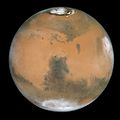Tiedosto:Mars and Syrtis Major - GPN-2000-000923.jpg
Siirry navigaatioon
Siirry hakuun

Tämän esikatselun koko: 600 × 600 kuvapistettä. Muut resoluutiot: 240 × 240 kuvapistettä | 480 × 480 kuvapistettä | 1 023 × 1 023 kuvapistettä.
Alkuperäinen tiedosto (1 023 × 1 023 kuvapistettä, 104 KiB, MIME-tyyppi: image/jpeg)
Tiedoston historia
Päiväystä napsauttamalla näet, millainen tiedosto oli kyseisellä hetkellä.
| Päiväys | Pienoiskuva | Koko | Käyttäjä | Kommentti | |
|---|---|---|---|---|---|
| nykyinen | 18. kesäkuuta 2012 kello 00.57 |  | 1 023 × 1 023 (104 KiB) | Tomruen | {{Information |Description ={{en|1=Mars Near Opposition 1995-2005: 1999 }} |Source =Replace with 2005 release: http://hubblesite.org/newscenter/archive/releases/solar%20system/mars/2005/34/image/h/ |Author =NASA |Date =2005... |
| 9. huhtikuuta 2009 kello 02.52 |  | 800 × 800 (227 KiB) | BotMultichillT | {{Information |Description={{en|1=Taking advantage of Mars's closest approach to Earth in eight years, astronomers using NASA's Hubble Space Telescope have taken the space-based observatory's sharpest views yet of the Red Planet. The telescope's Wide Fi |
Tiedoston käyttö
Seuraava sivu käyttää tätä tiedostoa:
Tiedoston järjestelmänlaajuinen käyttö
Seuraavat muut wikit käyttävät tätä tiedostoa:
- Käyttö sivustolla ar.wikipedia.org
- Käyttö sivustolla ca.wikipedia.org
- Käyttö sivustolla en.wikipedia.org
- Portal:Technology/Selected articles
- Portal:Technology/Selected articles/38
- History of Mars observation
- Portal:Outer space/Selected article
- Glossary of astronomy
- Portal:Outer space/Selected article/31
- Wikipedia:Today's featured article/January 2013
- Wikipedia:Today's featured article/January 8, 2013
- Wikipedia:Main Page history/2013 January 8
- Käyttö sivustolla es.wikipedia.org
- Käyttö sivustolla fr.wikipedia.org
- Käyttö sivustolla he.wikipedia.org
- Käyttö sivustolla id.wikipedia.org
- Käyttö sivustolla ja.wikipedia.org
- Käyttö sivustolla mwl.wikipedia.org
- Käyttö sivustolla os.wikipedia.org
- Käyttö sivustolla pt.wikipedia.org
- Käyttö sivustolla ru.wikipedia.org
- Käyttö sivustolla uk.wikipedia.org
- Käyttö sivustolla ur.wikipedia.org
- Käyttö sivustolla zh.wikipedia.org


